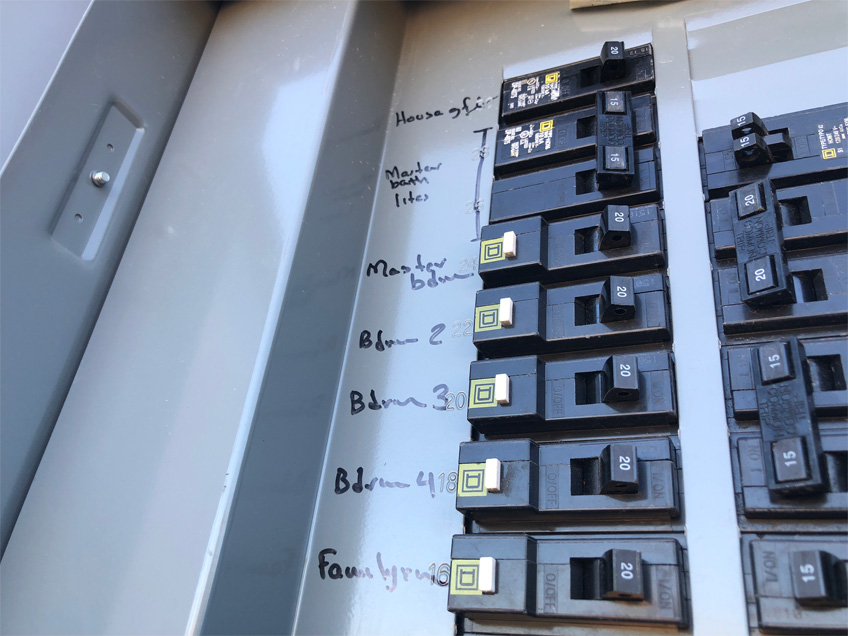With all the attention on “going electric” in 2023, homeowners and businesses need to be sure that electrical upgrades are done safely. New demands on existing circuits may be more than they were designed to handle, risking annoying breaker trips...and worse. That’s when a service upgrade is called for.
Carrying the Load
Household circuits carry either 120 or 240 volts, depending on what the circuit is designed to do. 120 volt circuits generally power lights and small appliances. They carry either 15 or 20 amperes (amps) of power to run everything from room lights to computers, TVs, and countertop appliances. 15 amp circuits are common for light switches and room outlets; 20 amp circuits are generally found in kitchens to run things like coffeemakers and microwaves that draw more current. They’re also found in garages and basements where shop equipment may be used. Electrical codes require permanently installed 120 volt appliances like garbage disposers, dishwashers, and over-the-range microwaves to have their own “dedicated” circuits.
Special breakers called ground fault and arc fault circuit interrupters (GFCI and AFCI) are required on lines where shock hazards are present such as in kitchens, bathrooms, basements, garages, and outdoor outlets. They can be installed at the box (the service panel) or inline closer to the outlet. Newer breakers that act as both ground and arc fault interrupters are available. As codes evolve, there’s a trend to require GFCI and/or AFCI breakers on all household outlets.
240 volt circuits do the heavy lifting. They’re used to power clothes dryers, water heaters, electric ranges and ovens, and heating and cooling equipment. You’ll see them as double-pole breakers in most service panels.
Matching the Breaker to the Load
Circuit breakers are designed to trip when a short is detected or the demand on the circuit exceeds the load the circuit is designed to carry. The breakers are marked with their rated load, typically 15 or 20 amps for 120 volt circuits and 30, 40, 50, up to 200 amps, for 240 volt circuits. The safety margin for breakers is 80% of their rated load.
Nearly all appliances have their power load (in amps) marked on them. That makes it simple to determine if your appliances will overload a circuit. Just add up the amp rating of them together when they’re used at the same time. If you can’t find the appliance’s amperage, use its wattage and divide that by the voltage (120) to get the amps (watts/volts=amps).
Matching the Circuit to the Load
If the draw on the circuit exceeds the its capacity, the circuit breaker will trip, disconnecting the entire circuit. That can often be prevented by shutting down one or more appliances and resetting the breaker at the panel. If that’s not the solution you want, the only way to prevent annoying trips is to upgrade the circuit or add another one.
Don’t be tempted to replace the offending breaker with a higher-capacity one. Chances are the wiring on the circuit isn’t designed to carry the higher load and will overheat or arc, resulting in disastrous circumstances.
Upgrading a Circuit
A licensed electrician can determine what’s needed to upgrade or add a circuit. Maybe the wiring will support a larger load if the wire gauge is sufficient. Count yourself lucky if that’s the case. It probably isn’t.
If the wiring needs to be upgraded, new wire will need to be pulled. If it can be run through open spaces in walls, floors, or ceilings, you’re still in luck. Otherwise, coverings like drywall may need to be removed to route the wire. A licensed electrician knows how to do this with the minimum amount of mess and disruption.
Replacing a Breaker
Sometimes breakers break and need to be replaced. A new or upgraded circuit will need a new breaker. This is work that should be left to a licensed electrician since lethal current is present at the service panel and breakers need to be matched to their function and the panel type. They also need to be installed correctly to prevent future problems from annoying to disastrous.
When It’s Time to Upgrade, It’s Time to Call a Pro
“Going electric” can be complicated and expensive. If not done carefully, it can cost more than money—it can pose serious risks to both your property and the precious things it houses.
Let Allstar Electrical Services help you assess the costs and benefits of such a move. Give us a call at 303.399.7420 or visit our website. We’re top-rated by the Better Business Bureau and a preferred contractor by Angi’s Home Advisor. We’re ready to work with you to get the results you expect and deserve.


